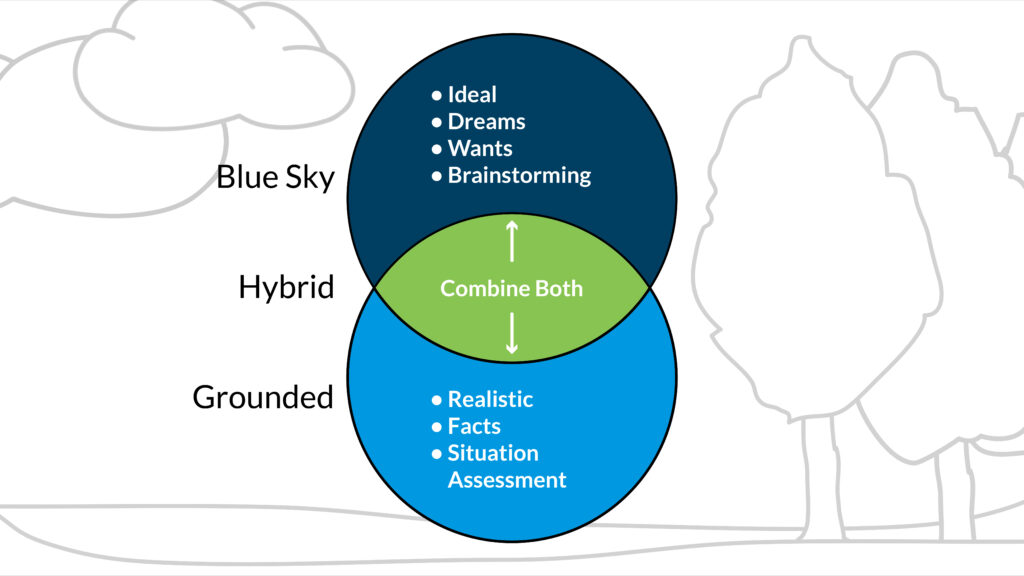There are two schools of thought and approaches to visioning. The first can be called the “blue sky” approach where residents envision their “ideal” community. When assisting communities with planning and visioning exercises, we sometimes ask “if you could wave your magic wand, what would your community look like?”
We can call the second method of visioning the “grounded” approach. It takes into account more explicitly the current situation and realistic opportunities for the community. As shown in the accompanying box, the grounded approach starts with a situation assessment of the community’s current socio-economic situation and its strengths and weaknesses. It asks citizens to envision a better future that is realistic given the current situation. For example, in the blue sky approach, a community might envision creating hundreds of new high paying jobs by attracting a vehicle assembly plant. The grounded approach might first take into account that the community is not located on an interstate highway and has a labor force too small to support a large industrial operation. The vision might instead be to create new high paying jobs and a goal would be to attract suppliers to vehicle assembly plants in nearby metro areas. A hybrid version of visioning is to start with the blue sky approach, conduct the situation assessment and then revise the initial vision based on the assessment. Some key ingredients to a successful visioning and strategic planning process are outlined in Chapter 3.

For the “grounded” or “hybrid” (both recommended over the “blue sky” approach in the authors’ opinion) to visioning, assets of the community as described in Chapter 3 need to be identified. Assets can be tangible such as infrastructure or quality of life, but they can also be intangible as discussed in Chapter 3 such as social capital and human capital. The liabilities or challenges to the community should be assessed along with the assets. This kind of exercise is often called “S.W.O.T.” analysis (Strengths, Weaknesses, Opportunities and Threats).
To see the importance of S.W.O.T. analysis for visioning, imagine that the board of directors of an ailing company has contracted with you, a noted business consultant, to develop a vision and plan to grow the company into profitability. Further, imagine that the board says “we’re not going to tell you anything about the company, we just want your ideas and plan.” You would be flying blind and you would be lucky if your vision and plan was realistic and achievable. On the other hand, if the board provides lots of information on its assets and opportunities, such as its labor force and management talent, its physical facilities and more, you would be in a much better situation to succeed. Even better, if the board provided you with information on the company’s challenges – perhaps aging products, rising competition and other liabilities and threats – your vision and plan would be based on reality and be much more likely to succeed. It’s the same with community visioning and planning – unless you conduct a thorough “S.W.O.T.” analysis to understand a community’s assets and liabilities, a vision and plan can be far from realistic, inviting failure and frustration. 1Examples of community vision statements are provided in the book.
2Laying the groundwork for a successful visioning and strategic planning process involves the following steps.
- Identifying who must be “at the table.” The short answer is everyone. All citizens should be given a chance to voice their opinion, but typically a list of community leaders and stakeholder organizations (usually several dozen) who will act as advocates for the process should be compiled. Names on the list should be balanced and reflect the socio-economic composition of the community.
- Designate the lead organization. While the steering committee described below has the ultimate responsibility for the planning and visioning project, the administrative responsibility must lie with some entity or organization in the community such as an economic development organization, county or municipal government, non-profit community organization, or similar entity.
- Design the process. Identify the components of the process and how to accomplish them. Establish the committees required to carry out the process. The most important committee is the coordinating or steering committee composed of 10 to 15 representative members of the community to establish and supervise the visioning and planning process. Other committees typically include an outreach committee responsible for informing citizens of the process and soliciting their input and assistance where necessary, and a research committee to perform the situation analysis and other information tasks shown in the box including gathering public input from surveys, focus groups, interviews and other channels. The visioning and strategic planning committees often grow out of the community action groups described in the Introduction toolbox.
- Set the project timetable.
- Staff the project. Ensure that the necessary personnel resources are available to complete the project, including staff and volunteers including committee members.
The process of gathering information for a situation assessment and soliciting input from residents of how they evaluate their community and what they would like it to be in the future will provide the raw material necessary to create a collective community vision. The process will also provide the information and input needed to customize the community’s roadmap to prosperity as shown in Chapter 2. Creating a roadmap to prosperity involves setting priorities for community and economic development – which assets to build on and liabilities to address in priority order, but this must be based on a vision for the future. Examples of community vision statements are provided in the book.
A community vision should be:
- Realistic and feasible. A “pie in the sky” vision that would be extremely difficult for a community to accomplish will only lead to frustration with the community and economic development process. At the same time, it should be a challenging, not a slam dunk, vision for the future.
- An overarching statement such as the examples in the book and above, not a detailed list of specific goals and action items. These should be developed separately based on the overarching vision statement.
- Clear and inspiring. Written in lay language that everyone in the community can readily understand, and that inspires residents to act on common values.
1For information on S.W.O.T. analyses, see Chapters 11 and 12 in Phillips and Pittman, An Introduction to Community Development, Second Edition, 2015.
2Adapted from Chapter 8 “Community Visioning and Strategic Planning” in Introduction to Community Development, 2nd edition, 2015, Phillips and Pittman.
![2021 Prosperous Places Logo [TM]](https://www.prosperousplaces.org/wp-content/uploads/2021/02/20210205_JI_PPTM-Logo.png)



